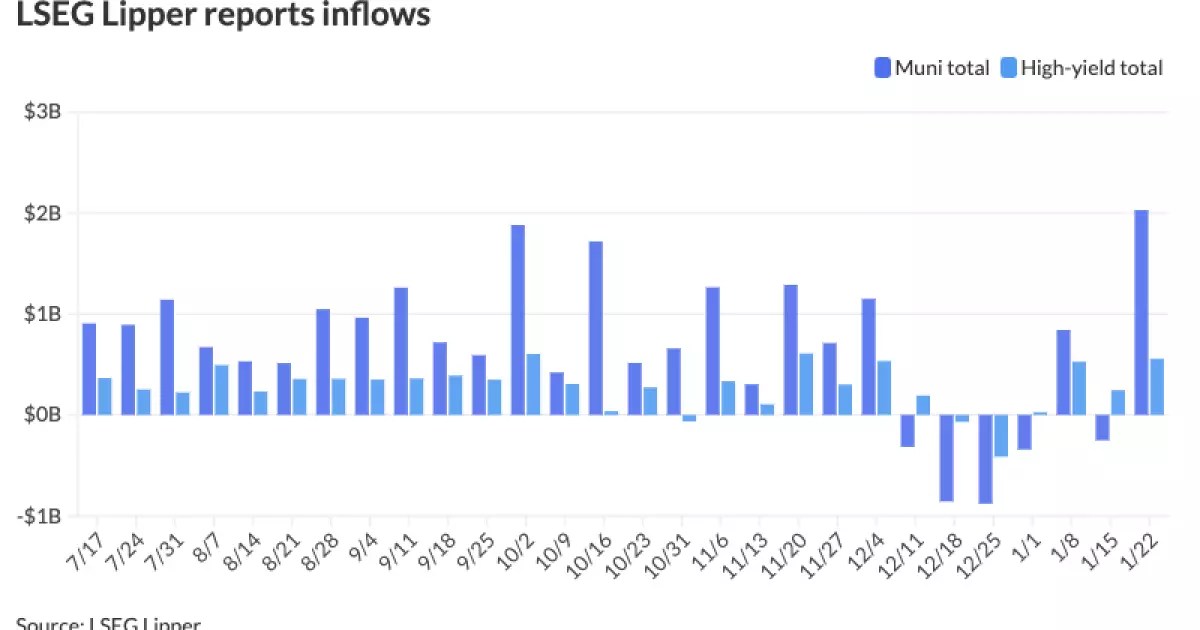The municipal bond market is currently encountering a mixed bag of trends, driven by fluctuating supply and investor demands. As seen recently, municipal securities have shown signs of weakness amid a notable slowdown in the primary market. Yet, despite these challenges, there have been significant inflows into municipal mutual funds, with investors adding over $2 billion, reflecting a growing appetite for quality municipal bonds. This article will examine the latest trends, pricing, and investment strategies impacting the municipal bond market.
Recent data indicates that U.S. Treasury yields have been on the rise, particularly for bonds maturing five years and beyond, which has inevitably influenced the municipal sector. For instance, the two-year municipal to U.S. Treasury (UST) ratio has hovered around 64%, while longer-dated bonds have seen ratios of 66% and 83%, respectively. These varying ratios signal the complex relationship between municipal and Treasury yields, with many investors finding current yields appealing despite underlying challenges in supply and demand.
Kim Olsan, a senior fixed-income portfolio manager at NewSquare Capital, noted that although the market has experienced a larger issuance of municipal bonds alongside reduced redemptions, investors remain bullish, pursuing legitimate yield opportunities. Notably, the issuance of high grade bonds during a single trading day has attracted bidders, culminating in tighter spreads than might typically be expected during weaker market conditions.
The competitive landscape for municipal issuances has sparked varied responses among investors. For instance, Washington State and Nevada general obligations (GOs) garnered notably narrow spreads indicating robust demand. Other significant issuances from AAA-rated Fairfax County and Mecklenburg County also experienced similarly snug spreads, further highlighting investor enthusiasm.
Amidst this competitive backdrop, some recent transactions indicate substantial investor interest. The Massachusetts Development Finance Agency’s $342.195 million revenue bonds met with strong demand, as evidenced by the pricing of multi-year maturities yielding favorable rates. Investors showed a keen inclination towards shorter maturities while exhibiting a steady appetite for slightly longer durations, which may reflect broader market expectations regarding future interest rate changes.
Investor sentiment has shifted notably in January, as the municipal bond market has seen a considerable uptick in flows. The week ending Wednesday resulted in a remarkable inflow of $2.028 billion into municipal bond mutual funds—the highest figure observed since early last year. This resurgence comes in contrast to the previous week, which saw outflows of $251.7 million, indicating a potential pivot in investor strategy and preference.
However, while some segments of the market are flourishing, tax-exempt municipal money market funds have faced substantial outflows, exacerbating supply concerns. These dynamics contribute to a mixed performance landscape, as the average yields for various municipal funds fluctuate in response to broader economic conditions.
Performance analysis by ratings shows that municipals have exhibited resilience across various credit ratings. AAA and AA-rated bonds have outperformed thus far in January, showcasing modest gains and stability. Notably, AAA-rated securities now represent a larger market share compared to previous months, capturing 26% of all trades in January. Meanwhile, single-A and BBB-rated revenue bonds have maintained a fairly consistent volume presence in the market, suggesting ongoing demand for diverse credit profiles.
Moreover, the current performance of indices reflects a slight preference for higher-rated bonds, potentially due to investors seeking safety in a volatile economic environment. The Bloomberg Barclays AAA index shows a modest increase, while the AA-rated index has lagged slightly behind, underscoring a cautious market sentiment.
As the municipal bond market continues to navigate challenges associated with fluctuating yields and competitive dynamics, the steady inflow of capital into mutual funds reveals a nuanced investor sentiment. Market participants are encouraged to adopt strategic approaches focusing on yield opportunities while remaining vigilant of shifting conditions. With ongoing developments in credit quality and issuance patterns, the landscape for municipal bonds will demand attentive strategies to capitalize on emerging trends and potential market fluctuations. Overall, the coming weeks will be pivotal in determining the trajectory of the municipal bond market as it adjusts to evolving economic signals and investor behaviors.


Leave a Reply